

Compact Muon Solenoid
LHC, CERN
| CMS-HIG-21-017 ; CERN-EP-2023-300 | ||
| Measurement of the production cross section of a Higgs boson with large transverse momentum in its decays to a pair of $ \tau $ leptons in proton-proton collisions at $ \sqrt{s} = $ 13 TeV | ||
| CMS Collaboration | ||
| 29 March 2024 | ||
| Submitted to Phys. Lett. B | ||
| Abstract: A measurement of the production cross section of a Higgs boson with transverse momentum greater than 250 GeV is presented where the Higgs boson decays to a pair of $ \tau $ leptons. It is based on proton-proton collision data collected by the CMS experiment at the CERN LHC at a center-of-mass energy of 13 TeV. The data sample corresponds to an integrated luminosity of 138 fb$ ^{-1} $. Because of the large transverse momentum of the Higgs boson the $ \tau $ leptons from its decays are boosted and produced spatially close, with their decay products overlapping. Therefore, a dedicated algorithm was developed to reconstruct and identify them. The observed (expected) significance of the measured signal with respect to the standard model background-only hypothesis is 3.5 (2.2) standard deviations. The product of the production cross section and branching fraction is measured to be 1.64 $ ^{+0.68}_{-0.54} $ times the standard model expectation. The fiducial differential production cross section is also measured as functions of the Higgs boson and leading jet transverse momenta. This measurement extends the probed large-transverse-momentum region beyond 600 GeV. | ||
| Links: e-print arXiv:2403.20201 [hep-ex] (PDF) ; CDS record ; inSPIRE record ; Physics Briefing ; CADI line (restricted) ; | ||
| Figures | |
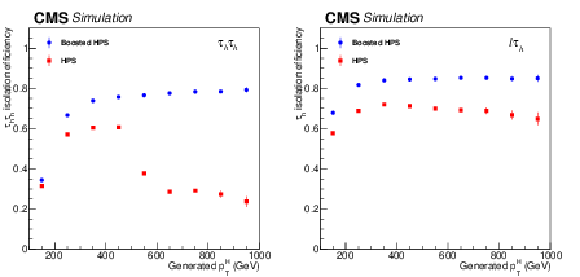
png pdf |
Figure 1:
Comparison of the isolation efficiencies for the standard and boosted HPS algorithms in the $ \tau_\mathrm{h}\tau_\mathrm{h} $ (left) and $ \ell\tau_\mathrm{h} $ (right) final states. |
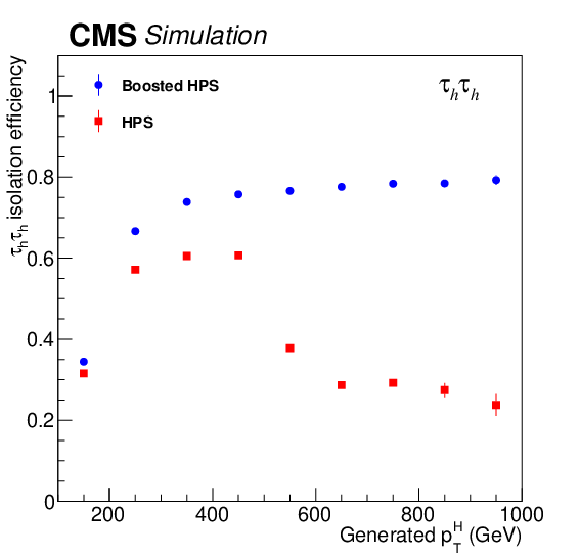
png pdf |
Figure 1-a:
Comparison of the isolation efficiencies for the standard and boosted HPS algorithms in the $ \tau_\mathrm{h}\tau_\mathrm{h} $ (left) and $ \ell\tau_\mathrm{h} $ (right) final states. |

png pdf |
Figure 1-b:
Comparison of the isolation efficiencies for the standard and boosted HPS algorithms in the $ \tau_\mathrm{h}\tau_\mathrm{h} $ (left) and $ \ell\tau_\mathrm{h} $ (right) final states. |

png pdf |
Figure 2:
Observed and expected NN distributions in the SR, after combining all four $ p_{\mathrm{T}}^{\mathrm{H}} $ bins, in the $ \mu\tau_\mathrm{h} $ (upper left), $ \mathrm{e}\tau_\mathrm{h} $ (upper right), $ \mathrm{e}\mu $ (lower left), and $ \tau_\mathrm{h}\tau_\mathrm{h} $ (lower right) channels. The signal and background distributions are the result of a simultaneous binned maximum likelihood fit to all three output NN distributions, including all individual $ p_{\mathrm{T}} $ bins and data-taking years. The bottom panel shows the ratio of the number of events observed in data to that of the expected background. |
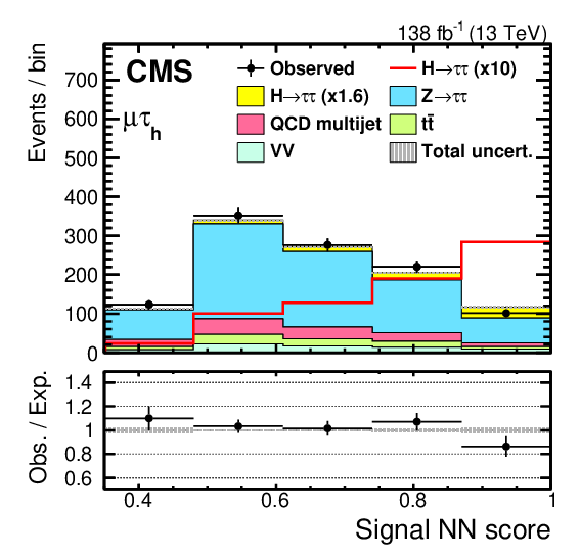
png pdf |
Figure 2-a:
Observed and expected NN distributions in the SR, after combining all four $ p_{\mathrm{T}}^{\mathrm{H}} $ bins, in the $ \mu\tau_\mathrm{h} $ (upper left), $ \mathrm{e}\tau_\mathrm{h} $ (upper right), $ \mathrm{e}\mu $ (lower left), and $ \tau_\mathrm{h}\tau_\mathrm{h} $ (lower right) channels. The signal and background distributions are the result of a simultaneous binned maximum likelihood fit to all three output NN distributions, including all individual $ p_{\mathrm{T}} $ bins and data-taking years. The bottom panel shows the ratio of the number of events observed in data to that of the expected background. |

png pdf |
Figure 2-b:
Observed and expected NN distributions in the SR, after combining all four $ p_{\mathrm{T}}^{\mathrm{H}} $ bins, in the $ \mu\tau_\mathrm{h} $ (upper left), $ \mathrm{e}\tau_\mathrm{h} $ (upper right), $ \mathrm{e}\mu $ (lower left), and $ \tau_\mathrm{h}\tau_\mathrm{h} $ (lower right) channels. The signal and background distributions are the result of a simultaneous binned maximum likelihood fit to all three output NN distributions, including all individual $ p_{\mathrm{T}} $ bins and data-taking years. The bottom panel shows the ratio of the number of events observed in data to that of the expected background. |
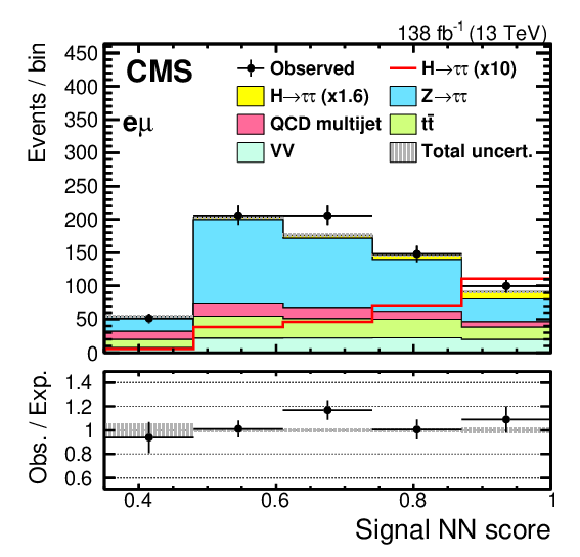
png pdf |
Figure 2-c:
Observed and expected NN distributions in the SR, after combining all four $ p_{\mathrm{T}}^{\mathrm{H}} $ bins, in the $ \mu\tau_\mathrm{h} $ (upper left), $ \mathrm{e}\tau_\mathrm{h} $ (upper right), $ \mathrm{e}\mu $ (lower left), and $ \tau_\mathrm{h}\tau_\mathrm{h} $ (lower right) channels. The signal and background distributions are the result of a simultaneous binned maximum likelihood fit to all three output NN distributions, including all individual $ p_{\mathrm{T}} $ bins and data-taking years. The bottom panel shows the ratio of the number of events observed in data to that of the expected background. |

png pdf |
Figure 2-d:
Observed and expected NN distributions in the SR, after combining all four $ p_{\mathrm{T}}^{\mathrm{H}} $ bins, in the $ \mu\tau_\mathrm{h} $ (upper left), $ \mathrm{e}\tau_\mathrm{h} $ (upper right), $ \mathrm{e}\mu $ (lower left), and $ \tau_\mathrm{h}\tau_\mathrm{h} $ (lower right) channels. The signal and background distributions are the result of a simultaneous binned maximum likelihood fit to all three output NN distributions, including all individual $ p_{\mathrm{T}} $ bins and data-taking years. The bottom panel shows the ratio of the number of events observed in data to that of the expected background. |
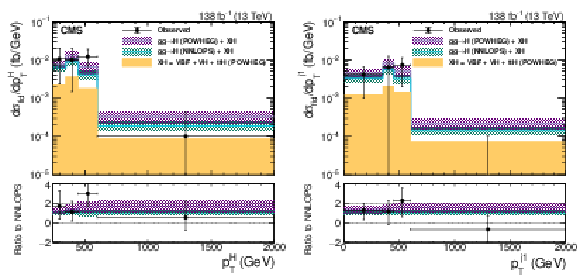
png pdf |
Figure 3:
Observed and expected differential fiducial cross sections in bins of $ p_{\mathrm{T}}^{\mathrm{H}} $ (left) and $ p_{\mathrm{T}}^{\mathrm{j}_1} $ (right). The last bins include the overflow. The uncertainty bands in the theoretical predictions include uncertainties from the following sources: PDF, renormalization and factorization scales, underlying event and parton showering, and the branching fraction $ \mathcal{B}(\mathrm{H}\to\tau\tau) $. |
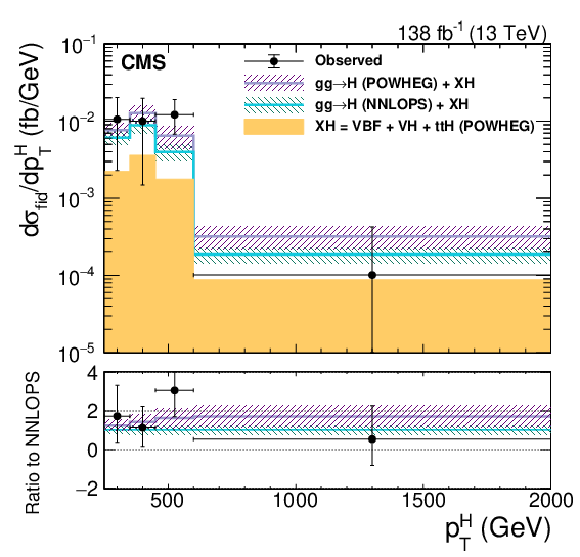
png pdf |
Figure 3-a:
Observed and expected differential fiducial cross sections in bins of $ p_{\mathrm{T}}^{\mathrm{H}} $ (left) and $ p_{\mathrm{T}}^{\mathrm{j}_1} $ (right). The last bins include the overflow. The uncertainty bands in the theoretical predictions include uncertainties from the following sources: PDF, renormalization and factorization scales, underlying event and parton showering, and the branching fraction $ \mathcal{B}(\mathrm{H}\to\tau\tau) $. |

png pdf |
Figure 3-b:
Observed and expected differential fiducial cross sections in bins of $ p_{\mathrm{T}}^{\mathrm{H}} $ (left) and $ p_{\mathrm{T}}^{\mathrm{j}_1} $ (right). The last bins include the overflow. The uncertainty bands in the theoretical predictions include uncertainties from the following sources: PDF, renormalization and factorization scales, underlying event and parton showering, and the branching fraction $ \mathcal{B}(\mathrm{H}\to\tau\tau) $. |
| Tables | |
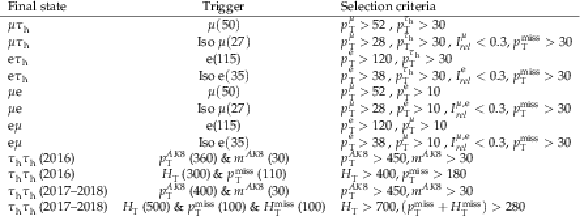
png pdf |
Table 1:
Selection requirements for the four $ \tau\tau $ final states. The relative isolation variable, $ I_{rel}^{\mu,\mathrm{e}} $, for muons and electrons is evaluated as the scalar sum of the $ p_{\mathrm{T}} $ of the reconstructed particles in a cone around the lepton track relative to the $ p_{\mathrm{T}} $ of the lepton. In the $ \tau_\mathrm{h}\tau_\mathrm{h} $ channel, the trigger requirement is defined by a combination of trigger candidates above a given threshold, indicated inside parentheses in GeV. The thresholds for the offline selection are driven by the trigger requirements. Except for the $ I_{rel}^{\mu,\mathrm{e}} $, the quantities are in units of GeV. |
| Summary |
| The measurement of the production cross section of a Higgs boson with large $ p_{\mathrm{T}} $ decaying to a pair of $ \tau $ leptons has been performed using proton-proton collision data collected by the CMS experiment at a center-of-mass energy of 13 TeV, corresponding to an integrated luminosity of 138 fb$ ^{-1} $. A dedicated reconstruction algorithm has been used to resolve the overlapping decay products of the two close-by $ \tau $ leptons. The $ \mathrm{H}\to\tau\tau $ signal with $ p_{\mathrm{T}}^{\mathrm{H}} > $ 250 GeV is established with a significance of 3.5 standard deviations (2.2 expected). The best fit of the product of the observed $ \mathrm{H}\to\tau\tau $ signal production cross section and branching fraction is 1.64 $ ^{+0.68}_{-0.54} $ times the SM expectation. The fiducial inclusive production cross section has been measured to be 3.88 $ ^{+1.69}_{-1.35} $ fb, which is consistent with the SM prediction of 2.36 $ \pm $ 0.51 fb. The fiducial differential production cross section is also measured as functions of the Higgs boson and leading jet transverse momenta. This measurement extends the probed large-transverse-momentum region beyond 600 GeV. No significant deviation with respect to the SM predictions is observed in the transverse momentum distribution of the Higgs boson with large $ p_{\mathrm{T}}^{\mathrm{H}} $. |
| References | ||||
| 1 | ATLAS Collaboration | Observation of a new particle in the search for the Standard Model Higgs boson with the ATLAS detector at the LHC | PLB 716 (2012) 1 | 1207.7214 |
| 2 | CMS Collaboration | Observation of a new boson at a mass of 125 GeV with the CMS experiment at the LHC | PLB 716 (2012) 30 | CMS-HIG-12-028 1207.7235 |
| 3 | CMS Collaboration | Observation of a new boson with mass near 125 GeV in pp collisions at $ \sqrt{s} = $ 7 and 8 TeV | JHEP 06 (2013) 081 | CMS-HIG-12-036 1303.4571 |
| 4 | ATLAS Collaboration | A detailed map of Higgs boson interactions by the ATLAS experiment ten years after the discovery | Nature 607 (2022) 52 | 2207.00092 |
| 5 | CMS Collaboration | A portrait of the Higgs boson by the CMS experiment ten years after the discovery. | Nature 607 (2022) 60 | CMS-HIG-22-001 2207.00043 |
| 6 | M. Battaglia, M. Grazzini, M. Spira, and M. Wiesemann | Sensitivity to BSM effects in the Higgs $ p_T $ spectrum within SMEFT | JHEP 11 (2021) 173 | 2109.02987 |
| 7 | C. Grojean, E. Salvioni, M. Schlaffer, and A. Weiler | Very boosted Higgs in gluon fusion | JHEP 05 (2014) 022 | 1312.3317 |
| 8 | M. Grazzini, A. Ilnicka, M. Spira, and M. Wiesemann | Modeling BSM effects on the Higgs transverse-momentum spectrum in an EFT approach | JHEP 03 (2017) 115 | 1612.00283 |
| 9 | ATLAS Collaboration | Measurements of differential cross sections of Higgs boson production through gluon fusion in the $ H\rightarrow WW^{*}\rightarrow e\nu \mu \nu $ final state at $ \sqrt{s} = $ 13 TeV with the ATLAS detector | EPJC 83 (2023) 774 | 2301.06822 |
| 10 | ATLAS Collaboration | Measurements of Higgs boson production cross-sections in the $ H\to\tau^{+}\tau^{-} $ decay channel in pp collisions at $ \sqrt{s} = $ 13 TeV with the ATLAS detector | JHEP 08 (2022) 175 | 2201.08269 |
| 11 | ATLAS Collaboration | Measurement of the total and differential Higgs boson production cross-sections at $ \sqrt{s} = $ 13 TeV with the ATLAS detector by combining the $ H \to ZZ^{*}\to 4\ell $ and $ H \to\gamma\gamma $ decay channels | JHEP 05 (2023) 028 | 2207.08615 |
| 12 | ATLAS Collaboration | Measurements of the Higgs boson inclusive and differential fiducial cross-sections in the diphoton decay channel with pp collisions at $ \sqrt{s} = $ 13 TeV with the ATLAS detector | JHEP 08 (2022) 027 | 2202.00487 |
| 13 | ATLAS Collaboration | Constraints on Higgs boson production with large transverse momentum using $ H\to bb $ decays in the ATLAS detector | PRD 105 (2022) 092003 | 2111.08340 |
| 14 | ATLAS Collaboration | Measurements of the Higgs boson inclusive and differential fiducial cross sections in the 4$ \ell $ decay channel at $ \sqrt{s} = $ 13 TeV | EPJC 80 (2020) 942 | 2004.03969 |
| 15 | CMS Collaboration | Measurements of inclusive and differential cross sections for the Higgs boson production and decay to four-leptons in proton-proton collisions at $ \sqrt{s} = $ 13 TeV | JHEP 08 (2023) 040 | CMS-HIG-21-009 2305.07532 |
| 16 | CMS Collaboration | Measurement of the Higgs boson inclusive and differential fiducial production cross sections in the diphoton decay channel with pp collisions at $ \sqrt{s} = $ 13 TeV | JHEP 07 (2023) 091 | CMS-HIG-19-016 2208.12279 |
| 17 | CMS Collaboration | Measurement of the inclusive and differential Higgs boson production cross sections in the decay mode to a pair of $ \tau $ leptons in pp collisions at $ \sqrt{s} = $ 13 TeV | PRL 128 (2022) 081805 | CMS-HIG-20-015 2107.11486 |
| 18 | CMS Collaboration | Inclusive search for highly boosted Higgs bosons decaying to bottom quark-antiquark pairs in proton-proton collisions at $ \sqrt{s} = $ 13 TeV | JHEP 12 (2020) 085 | CMS-HIG-19-003 2006.13251 |
| 19 | CMS Collaboration | Measurement and interpretation of differential cross sections for Higgs boson production at $ \sqrt{s} = $ 13 TeV | PLB 792 (2019) 369 | CMS-HIG-17-028 1812.06504 |
| 20 | CMS Collaboration | Precision luminosity measurement in proton-proton collisions at $ \sqrt{s} = $ 13 TeV in 2015 and 2016 at CMS | EPJC 81 (2021) 800 | CMS-LUM-17-003 2104.01927 |
| 21 | CMS Collaboration | CMS luminosity measurement for the 2017 data-taking period at $ \sqrt{s} = $ 13 TeV | CMS Physics Analysis Summary, 2018 CMS-PAS-LUM-17-004 |
CMS-PAS-LUM-17-004 |
| 22 | CMS Collaboration | CMS luminosity measurement for the 2018 data-taking period at $ \sqrt{s} = $ 13 TeV | CMS Physics Analysis Summary, 2019 CMS-PAS-LUM-18-002 |
CMS-PAS-LUM-18-002 |
| 23 | CMS Collaboration | Performance of the CMS Level-1 trigger in proton-proton collisions at $ \sqrt{s} = $ 13 TeV | JINST 15 (2020) P10017 | CMS-TRG-17-001 2006.10165 |
| 24 | CMS Collaboration | The CMS trigger system | JINST 12 (2017) P01020 | CMS-TRG-12-001 1609.02366 |
| 25 | CMS Collaboration | The CMS experiment at the CERN LHC | JINST 3 (2008) S08004 | |
| 26 | P. Nason | A new method for combining NLO QCD with shower Monte Carlo algorithms | JHEP 11 (2004) 040 | hep-ph/0409146 |
| 27 | S. Frixione, P. Nason, and C. Oleari | Matching NLO QCD computations with Parton Shower simulations: the POWHEG method | JHEP 11 (2007) 070 | 0709.2092 |
| 28 | S. Alioli, P. Nason, C. Oleari, and E. Re | A general framework for implementing NLO calculations in shower Monte Carlo programs: the POWHEG BOX | JHEP 06 (2010) 043 | 1002.2581 |
| 29 | S. Alioli, P. Nason, C. Oleari, and E. Re | NLO higgs boson production via gluon fusion matched with shower in POWHEG | JHEP 04 (2009) 002 | 0812.0578 |
| 30 | K. Hamilton, P. Nason, E. Re, and G. Zanderighi | NNLOPS simulation of Higgs boson production | JHEP 10 (2013) 222 | 1309.0017 |
| 31 | K. Hamilton, P. Nason, and G. Zanderighi | Finite quark-mass effects in the NNLOPS POWHEG+MiNLO Higgs generator | JHEP 05 (2015) 140 | 1501.04637 |
| 32 | J. Alwall et al. | The automated computation of tree-level and next-to-leading order differential cross sections, and their matching to parton shower simulations | JHEP 07 (2014) 079 | 1405.0301 |
| 33 | J. Alwall et al. | Comparative study of various algorithms for the merging of parton showers and matrix elements in hadronic collisions | EPJC 53 (2008) 473 | 0706.2569 |
| 34 | T. Melia, P. Nason, R. Rontsch, and G. Zanderighi | $ W^+ W^- $, $ WZ $ and $ ZZ $ production in the POWHEG BOX | JHEP 11 (2011) 078 | 1107.5051 |
| 35 | P. Nason and G. Zanderighi | $ W^+ W^- $, $ WZ $ and $ ZZ $ production in the POWHEG-BOX-V2 | EPJC 74 (2014) 2702 | 1311.1365 |
| 36 | S. Alioli, P. Nason, C. Oleari, and E. Re | NLO single-top production matched with shower in POWHEG: s- and t-channel contributions | JHEP 09 (2009) 111 | 0907.4076 |
| 37 | E. Re | Single-top Wt-channel production matched with parton showers using the POWHEG method | EPJC 71 (2011) 1547 | 1009.2450 |
| 38 | NNPDF Collaboration | Parton distributions for the LHC Run II | JHEP 04 (2015) 040 | 1410.8849 |
| 39 | T. Sjöstrand et al. | An introduction to PYTHIA 8.2 | Comput. Phys. Commun. 191 (2015) 159 | 1410.3012 |
| 40 | CMS Collaboration | Event generator tunes obtained from underlying event and multiparton scattering measurements | EPJC 76 (2016) 155 | CMS-GEN-14-001 1512.00815 |
| 41 | CMS Collaboration | Extraction and validation of a new set of CMS PYTHIA8 tunes from underlying-event measurements | EPJC 80 (2020) 4 | CMS-GEN-17-001 1903.12179 |
| 42 | GEANT4 Collaboration | GEANT 4: A simulation toolkit | NIM A 506 (2003) 250 | |
| 43 | CMS Collaboration | Particle-flow reconstruction and global event description with the CMS detector | JINST 12 (2017) P10003 | CMS-PRF-14-001 1706.04965 |
| 44 | CMS Collaboration | Technical proposal for the Phase-II upgrade of the Compact Muon Solenoid | CMS Technical Proposal CERN-LHCC-2015-010, CMS-TDR-15-02, 2015 CDS |
|
| 45 | M. Cacciari, G. P. Salam, and G. Soyez | The anti-$ k_{\mathrm{T}} $ jet clustering algorithm | JHEP 04 (2008) 063 | 0802.1189 |
| 46 | M. Cacciari, G. P. Salam, and G. Soyez | FastJet user manual | EPJC 72 (2012) 1896 | 1111.6097 |
| 47 | CMS Collaboration | Jet energy scale and resolution in the CMS experiment in pp collisions at 8 TeV | JINST 12 (2017) P02014 | CMS-JME-13-004 1607.03663 |
| 48 | CMS Collaboration | Pileup mitigation at CMS in 13 TeV data | JINST 15 (2020) P09018 | CMS-JME-18-001 2003.00503 |
| 49 | CMS Collaboration | Performance of tau-lepton reconstruction and identification in CMS | JINST 7 (2012) P01001 | CMS-TAU-11-001 1109.6034 |
| 50 | CMS Collaboration | Reconstruction and identification of $ \tau $ lepton decays to hadrons and $ \nu_{\tau} $ at CMS | JINST 11 (2016) P01019 | CMS-TAU-14-001 1510.07488 |
| 51 | CMS Collaboration | Performance of reconstruction and identification of $ \tau $ leptons decaying to hadrons and $ \nu_\tau $ in pp collisions at $ \sqrt{s}= $ 13 TeV | JINST 13 (2018) P10005 | CMS-TAU-16-003 1809.02816 |
| 52 | M. Wobisch and T. Wengler | Hadronization corrections to jet cross-sections in deep inelastic scattering | in Workshop on Monte Carlo Generators for HERA Physics (Plenary Starting Meeting), 1998 | hep-ph/9907280 |
| 53 | CMS Collaboration | Performance of missing transverse momentum reconstruction in proton-proton collisions at $ \sqrt{s} = $ 13 TeV using the CMS detector | JINST 14 (2019) P07004 | CMS-JME-17-001 1903.06078 |
| 54 | A. J. Larkoski, S. Marzani, G. Soyez, and J. Thaler | Soft Drop | JHEP 05 (2014) 146 | 1402.2657 |
| 55 | CMS Collaboration | Identification of heavy-flavour jets with the CMS detector in pp collisions at 13 TeV | JINST 13 (2018) P05011 | CMS-BTV-16-002 1712.07158 |
| 56 | L. Bianchini et al. | Reconstruction of the Higgs mass in events with Higgs bosons decaying into a pair of $ \tau $ leptons using matrix element techniques | NIM A 862 (2017) 54 | 1603.05910 |
| 57 | CMS Collaboration | Constraints on anomalous higgs boson couplings to vector bosons and fermions from the production of higgs bosons using the $ \tau\tau $ final state | PRD 108 (2022) 032013 | CMS-HIG-20-007 2205.05120 |
| 58 | CMS Collaboration | Jet algorithms performance in 13 TeV data | CMS Physics Analysis Summary, 2017 CMS-PAS-JME-16-003 |
CMS-PAS-JME-16-003 |
| 59 | J. M. Campbell, R. K. Ellis, and C. Williams | Vector boson pair production at the LHC | JHEP 07 (2011) 018 | 1105.0020 |
| 60 | M. Czakon and A. Mitov | Top++: A Program for the Calculation of the Top-Pair Cross-Section at Hadron Colliders | Comput. Phys. Commun. 185 (2014) 2930 | 1112.5675 |
| 61 | T. Gehrmann et al. | $ W^+W^- $ Production at Hadron Colliders in Next to Next to Leading Order QCD | PRL 113 (2014) 212001 | 1408.5243 |
| 62 | K. Melnikov and F. Petriello | Electroweak gauge boson production at hadron colliders through $ O(\alpha_s^2) $ | PRD 74 (2006) 114017 | hep-ph/0609070 |
| 63 | CMS Collaboration | Measurement of Differential Top-Quark Pair Production Cross Sections in $ pp $ collisions at $ \sqrt{s}= $ 7 TeV | EPJC 73 (2013) 2339 | CMS-TOP-11-013 1211.2220 |
| 64 | CMS Collaboration | Measurement of the differential cross section for top quark pair production in pp collisions at $ \sqrt{s} = $ 8 TeV | EPJC 75 (2015) 542 | CMS-TOP-12-028 1505.04480 |
| 65 | LHC Higgs Cross Section Working Group Collaboration | Handbook of LHC Higgs cross sections: 4. Deciphering the nature of the Higgs sector | technical report, . , , CERN Yellow Reports: Monographs, 2016 link |
1610.07922 |
| 66 | R. Barlow and C. Beeston | Fitting using finite Monte Carlo samples | Comput. Phys. Commun. 77 (1993) 219 | |
| 67 | J. S. Conway | Incorporating nuisance parameters in likelihoods for multisource spectra | PHYSTAT 201 (2011) 115 | 1103.0354 |
| 68 | ATLAS and CMS Collaborations, and LHC Higgs Combination Group | Procedure for the LHC Higgs boson search combination in Summer 2011 | Technical Report CMS-NOTE-2011-005, ATL-PHYS-PUB-2011-11, 2011 | |
| 69 | CMS Collaboration | HEPData record for this analysis | link | |

|
Compact Muon Solenoid LHC, CERN |

|

|

|

|

|

|